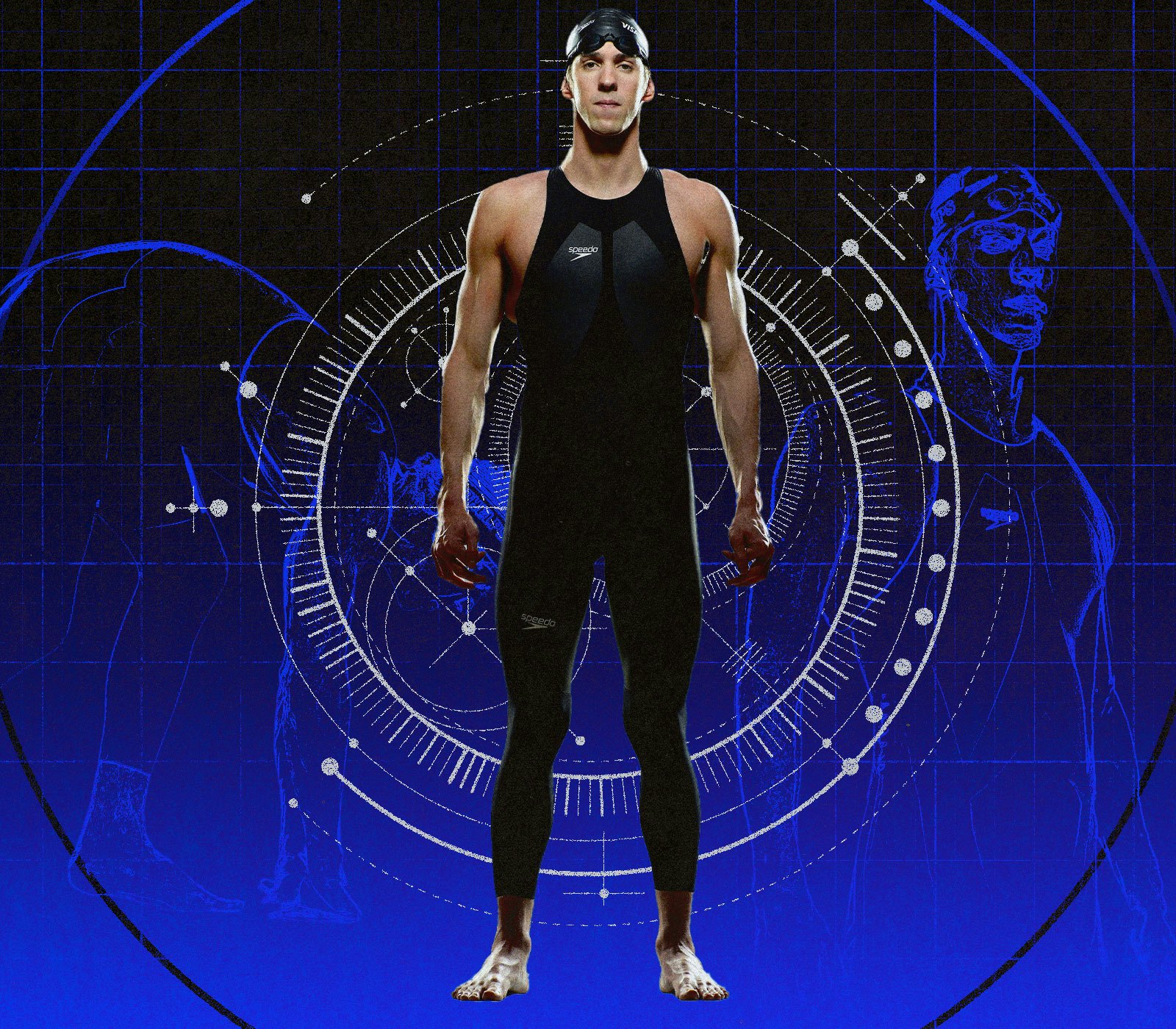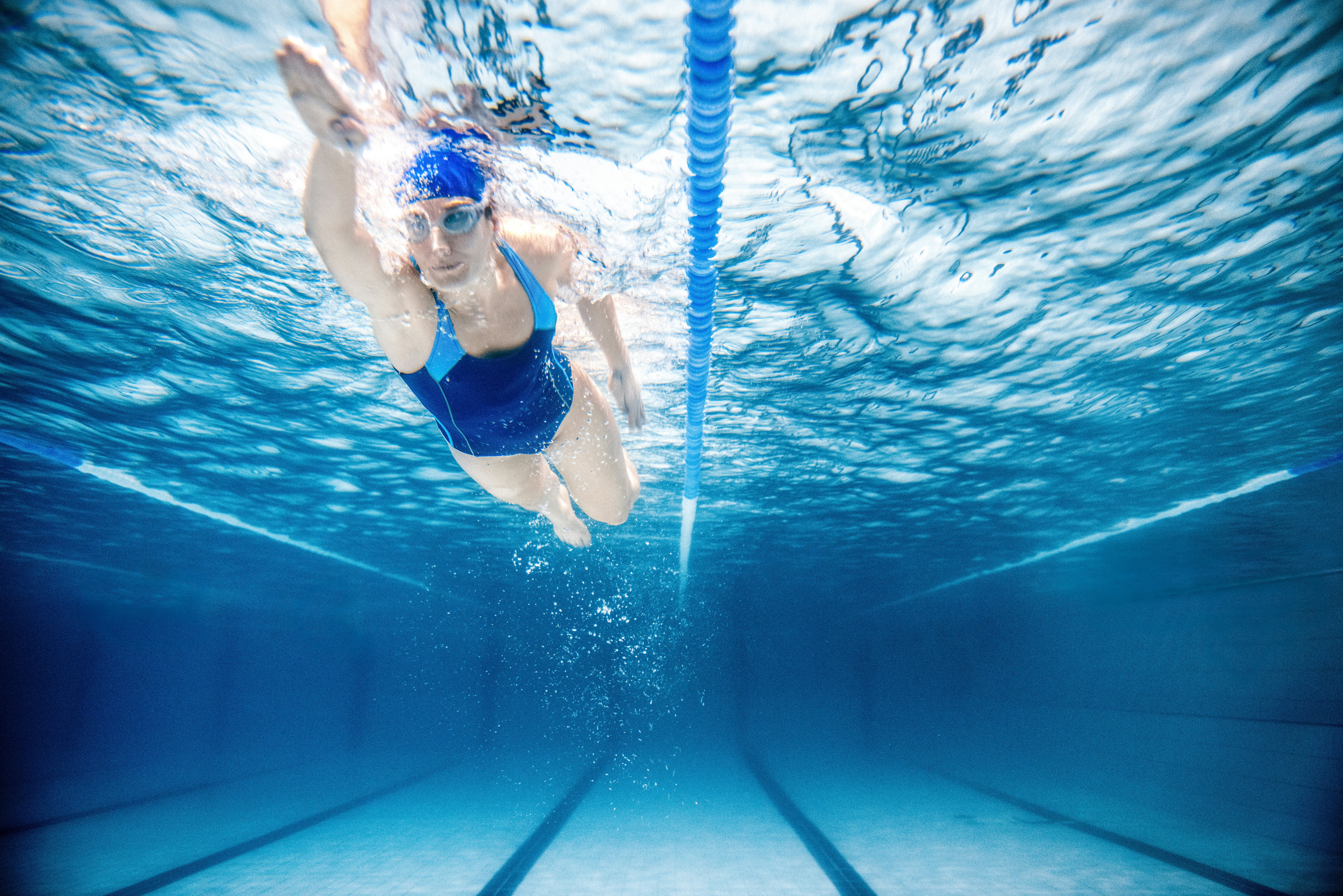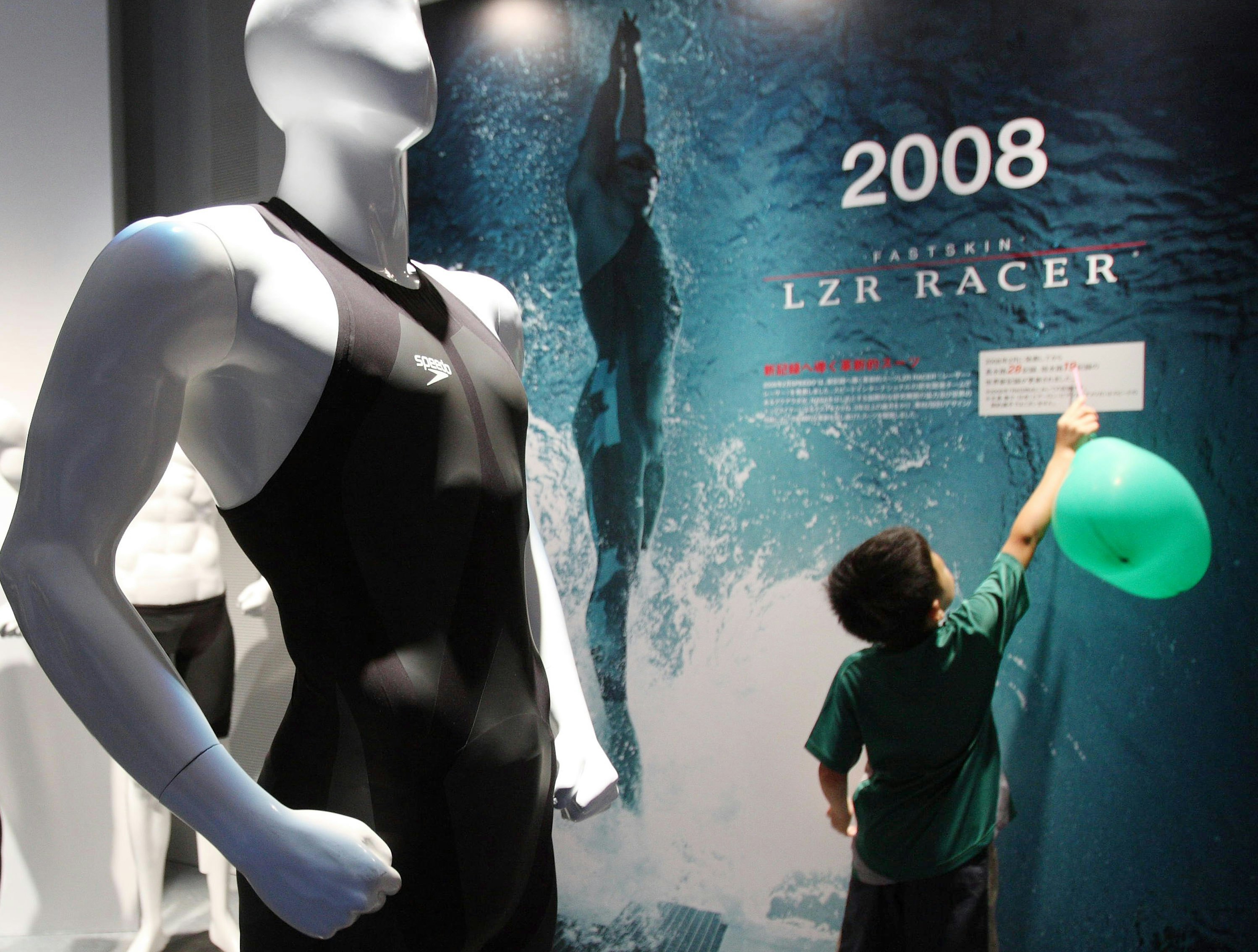
There’s a video making rounds in the lead-up to the 2024 Paris Olympics that is a bit of a weird watch. The NBC short features three-time Olympian Elizabeth Beisel squeezing into a competitive swimsuit. “Squeezing” doesn’t really do it justice. She has to stretch, fold, and contort herself into the suit in a clearly trying process — at one point, this gold medalist seems out of breath — that takes 30 minutes by her estimate.
Almost any casual viewer of high-level swimming knows that the juice is worth the squeeze. Sixteen years ago, one of the most high-profile cases of potential “technological doping” took the Beijing Olympics by storm. For those who watched, it’s hard to forget first seeing the lanky Michael Phelps readying himself by the pool in a tight shark-gray sleeveless suit that covered him from knee to neck with an “X” patterned across the front. It was a suit worthy of a superhero — and the feats that followed were nothing short of that.
The Speedo LZR Racer, one of Time magazine’s “Best Inventions of 2008,” has since been banned — as have other iterations of swimsuits that, experts found, gave athletes an unfair advantage in buoyancy, support, and faster-than-skin drag. The race times in ‘08 and the following World Championship in ‘09 were given an unofficial asterisk, but they stood — and, to the notable applause of Phelps, racers have finally caught up with them with suits that are, yes, still tight as hell, but a little less helpful in the water.

Athletic progress is part and parcel to the Olympics. Times fall, occasionally precipitously, thanks to a few main factors. What we might call technique is the most respected one. Athletes training harder, smarter, and more than those before them get all our adoration. Of course, biology plays a role — athletes work with what they’re given after all. (Put Simone Biles and Katie Ledecky next to each other and it’s easy enough to guess who would excel at what event.) There’s doping of course, the maligned “cheats” of the Olympics who do get official asterisks, and medals taken away. And then there’s the most slippery progress — that of technology.
“To say no to innovation, that's very unhealthy,” says Jan-Anders Mansson, the current executive director of the Ray Ewry Sports Engineering Center at Purdue University. “But we need to make it so it's the same for everyone. So now it's the question, ‘What are the limits of technology in sports — how can we control it?’”
The question is one that, going into the 2024 Olympic Games, is on Mansson’s mind. Mansson is also the chairman of the Swimwear Approval Committee of the International Federation of Swimming (FINA) and on the Board of IOC’s Athlete365 Learning Gateway. He has served as Chairman of the Swimwear Approval Committee of the International Federation of Swimming, headed up R&D for the Swiss America’s Cup yacht and is a member of the Swedish and the Swiss Academy of Engineering Sciences. In other words, he lives and breathes sports tech and is just the person to discuss the limits of Olympians and balancing innovations that are accessible, safe, and bring people into sport. The short of our conversation: Technology makes the games better for us all — as long as the checks and balances are well in place.
Why Humans Keep Getting Faster, Stronger, Better
What makes a winning Olympic athlete? Socrates had a now-oft-rehashed answer to that: “It is not the most attractive and the strongest who are crowned, but those who compete.” It’s safe to say that the ancient Greek philosopher wasn’t quite thinking about LZR Racing suits when he came up with this. (It was apparently customary to compete in the nude or near-nude in early years of the Olympics.) But the march of progress in athletic competition requires more people to show us different ways to push the limits of the human body, the impact of training and effort, and, at least today, technological innovations.
“There's many things that influence records,” says Mansson, breaking it down in his methodical scientific manner: “There is the human societal evolution, talents and gene selection, and popularity of sport (more people means more talent into a sport).” Put this all together and you get some consistent measurable gains with records making roughly a 1 percent gain over a four-year time, at least in swimming, says Mansson. If there is equipment involved, he notes, it is often a little bit more.

So 1 percent over four years? That’s slim margins. In one sense, it’s a recipe for great competition — a nail-biting gap for us to cheer our athlete of choice. “It's about small things making a huge difference,” says Mansson. “That's what they call the marginal gains.”
Biology (“innate talent”) and training and technology all have their margins, of course, but rules and techniques play a part too. Consider the flip turn. In swimming, a great leap came in the 1950s with the introduction of this turnaround method. Times fell fast soon after its advent. Another big leap in the pool was in the 1980s with a change to the pool design itself — water filling up to the edge so there were less waves to fight and less need for a lane without the turbulence. With smoother waters, times fell again.
Swimsuit technology, in other words, might not have such an outsize influence as we think. Looking back to Michael Phelps’ eight-gold-medal reign in the 2008 Olympics, Mansson believes that without tech, “he would just have seven.” So much for the big advantage of banned tech? Then again, a gold medal in the Olympics is… a gold medal in the Olympics.
The Advantage Of A Swimsuit
An advantage is an advantage is an advantage, and the Olympic Committee isn’t about to ignore even small technological gains. Hence, the 2024 suits are less a leap in swimming technology than a dialing back. But what, exactly, is the big advantage of a 2008 suit? The tech is simple when you look closely — and rather ingenious.
First of all, full-body suits help with body stabilization and compression. Muscles that wobble after all will impact turbulence in the water. Besides that, the suit acts like a sort of second six-pack, something that helps to keep your body more easily horizontal, more dolphin-like all around. These elastic forces, says Mansson, really only pertain to “the last 20 percent of the race, when you get tired, your butt sinks down and you start to plow in water.” You being an ultra-fit Olympic swimmer, of course.
The secondary, and potentially bigger advantage of the suits — the LZR and their ilk specifically — is buoyancy. Because these suits are impermeable, they’re able to trap air inside and keep swimmers even more horizontal. Feeling more dolphin-like all the time.
There's a real, if small, advantage to these suits. But also, “when everything feels good, you can never neglect the placebo effect.” So the data and consensus shows that these pricey ($600-plus) and often proprietary suits had to go. How, exactly?
“The major change was moving to textile suits,” says Mansson, suits with “a certain permeability.” To be exact, 80 liters per meter square a second. Meaning, if you direct a jet of air onto a suit, 80 liters of it should be able to pass through every second for every meter of fabric. Also, for men at least, there will be less fabric overall. Bottoms only, fellas. They’ll still be tight as possible, working with the material they have (see Elizabeth Beisel squeezing into the suit, above), but at the end of the day, the powers that be felt this amount of suit levels the playing field.

When swimmers show up to Paris this year, they will already have a sanctioned suit. Well before the Games, swimmers have to get their suits approved, to send them in to get the permeability (8 liters/meter/second) and thickness tested (they can't be thicker than 0.8 millimeter to minimize the elastic forces in the suit). Other checks would be made — to see if there are any coatings on the suit or if any other sneaky technological trick makes its way in. If they are not approved, they can resubmit to change the suits so they get approved. If they are approved, they get an official mark on the suits.
Just minutes before the start, swimmers will get in line and be checked once again. “They show their goggles, their cap and we check that they have the approval mark on the suits,” says Mansson. “And so when they then three, four minutes later go up and start, we know they all have approved swimsuits.”
How Tech Can Save (Or Ruin) Sports
The worst of the Olympics — the stains and moments that are looked back with disdain — are when there is a clear unlevel playing field. Doping is the usual source of such issues, but it can be technological. “The technology should be in the shadow of the athletes,” Mansson says, and not the other way around.
This means when technology is introduced to the games, the experts look first for a “level playing field, accessibility, and affordability,” says Mansson. And of course, safety and security. Swimsuits are probably never going to get so tight as to choke a swimmer, but bows, bobsleds, or, heck, a javelin need to be limited to make sure that they don’t cause harm to the athletes or those around them. There’s a bit of tradition too. A kick flip is a fair advance in swimming that you might improves the sport — it’s so much smoother and more graceful. But what if recumbent bikes are were replace the road bikes we all know? They might technically be faster — according to aerodynamics at least — but do they belong in the century-long tradition of upright road biking? Probably not.
That is to say, technology is a tricky balance. On one hand, a fast swim suit can create excitement — who doesn’t want to see records being shattered and swimmers flying through the water like never before? On the other, it might start to chip away at the sport’s appeal. At the end of the day, we should think about the kids watching Olympians compete for the first time. Will they see themselves in the sport? Will they be inspired? Will they be the next generation to take the torch and find a way to be faster, stronger, or better? “It has to have integrity — so we can send our kids there,” says Mansson. “That's how I think about sport.”







